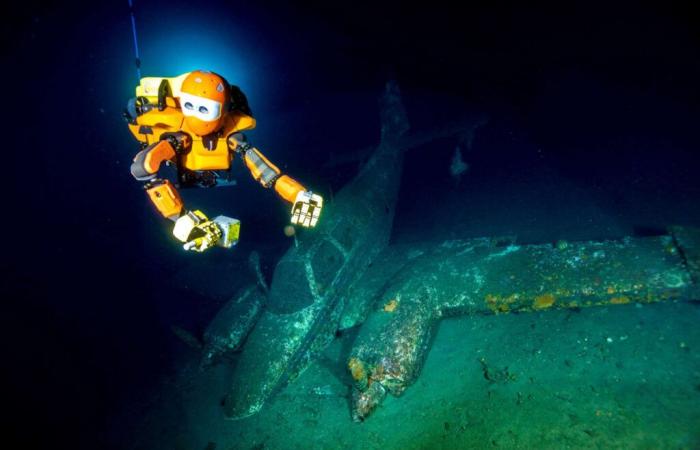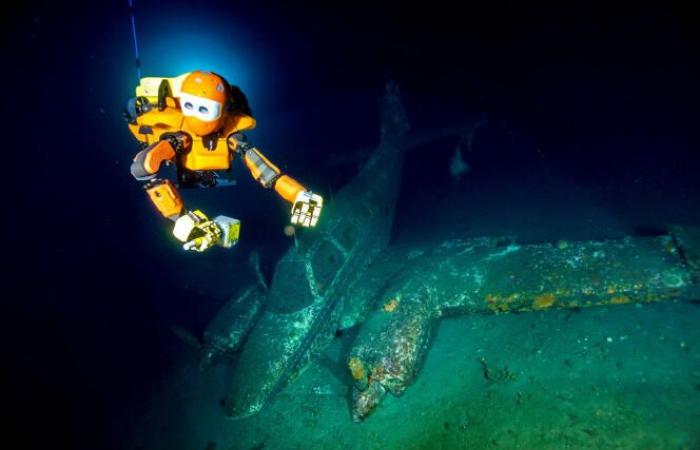PLANET+ – MONDAY SEPTEMBER 2 AT 8:55 PM – DOCUMENTARY
It could look like something out of a science fiction movie. A humanoid robot that looks like Iron Man or Isaac Asimov’s Speedy SPD-13, with two cameras for eyes, mechanical arms and hands… The machine searches wrecks at great depths like a diver would.
In the era of AI and the “augmented man”, Ocean One K opens a new era of underwater archaeology. Mathieu Pradinaud’s documentary takes us on a journey through the first six days of diving with this revolutionary robot, off the coast of Marseille and Corsica.
Read also | Article reserved for our subscribers “The humanoid robot Ocean One can go up to 1000 meters deep”
Add to your selections
This machine was developed by the Robotic Lab, the robotics laboratory of Stanford University in San Francisco (California), in cooperation with the Department of Underwater and Submarine Archaeological Research (Drassm), based in Marseille. Packed with sensors, Ocean One K is directed from the surface, via a sort of umbilical cord connected to a boat, by a human equipped with 3D glasses and haptic controls, which allow him to feel what the robot discovers and touches.
“A human avatar”
“He is an avatar of a human being with exceptional abilitiesrejoices his “father”, Oussama Khatib, roboticist and professor of computer science at Stanford. Les robots [sous-marins] So far, robots are designed to see, we need robots to act.”
The tragic submarine accident Titanwhich imploded as it approached the wreck of the Titanic at a depth of 3,800 meters, in June 2023, with five people on board, cruelly reminded us that, given the current state of underwater exploration technology, man cannot dive to the depths of the abyss himself to conduct archaeological excavations. Historians do not intend to ignore “the largest museum in the world” what are the oceans.
With its almost unlimited autonomy, Ocean One K is therefore invested with a mission: “To ensure that one day we can work in very great depths, where humans have absolutely no place”sums up Michel L’Hour, former head of the DRASSM, member of the Marine Academy – whom some have dubbed “Indiana Jones in a diving suit”.
Historical and human issues
During these six days of testing, Ocean One K will dive deeper and deeper to explore recent or (very) old wrecks. From a Lockheed P-38, a fighter plane that disappeared in 1944 in the bay of La Ciotat, to a Roman ship from the time of Emperor Hadrian (around 130 AD), found off the coast of Bastia; from the submarine Proteus sunk in December 1943 between Algiers and Marseille, at a depth of 120 meters, at the Lunea ship of Louis XIV sunk off the coast of Toulon in July 1664.
The World Workshops
Online courses, evening classes, workshops: develop your skills
Discover
While scientists and marine historians are eager to explain the reasons for this or that shipwreck, they are keen to point out that the stakes of a robot of the abyss like Ocean One K are not only historical but also human. There could have been in the Proteussays Michel L’Hour, written testimonies from crew members who survived the shipwreck in a watertight box: “Some might have considered, in the time they had left of life, leaving a message to posterity and to their family.” This was the great hope of Christian Le Cléach, born the year his father, Eugène, a 25-year-old quartermaster, was reported missing with the entire crew of 74 men of the Proteus.
Ocean One K. The robot of the abyssby Mathieu Pradinaud for Gedeon Programmes (Fr., 2022, 90 min).







